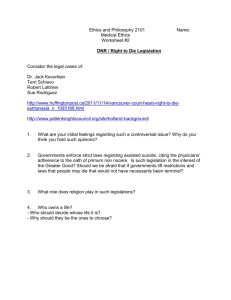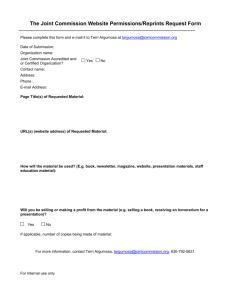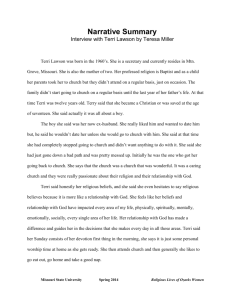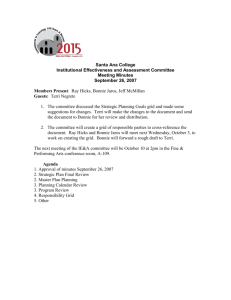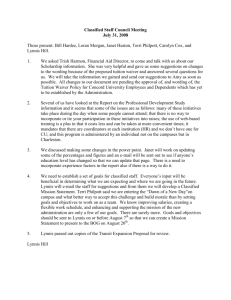File - Rachel Dorsey
advertisement
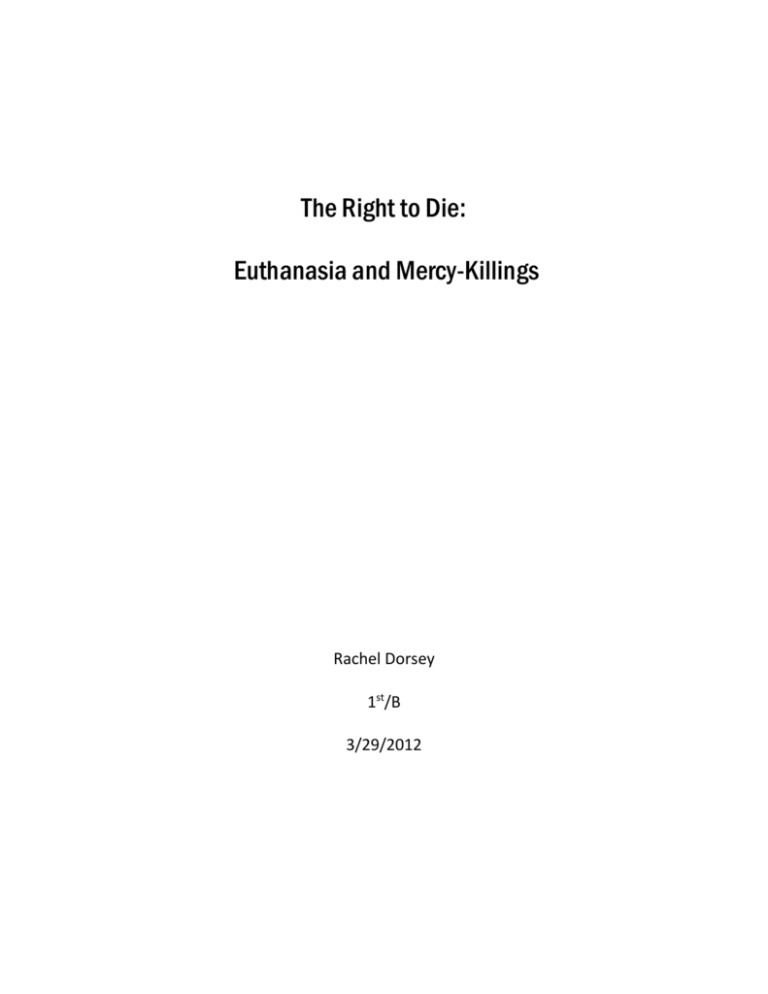
The Right to Die: Euthanasia and Mercy-Killings Rachel Dorsey 1st/B 3/29/2012 Most would agree that taking a loved one’s life by their own hand is a much more humane act than consciously allowing them to suffer; however, in the eyes of the United States legal system, euthanasia is criminal. As stated in the Merriam-Webster Dictionary, euthanasia is “the act or practice of killing or permitting the death of hopelessly sick or injured individuals (as persons or domestic animals) in a relatively painless way for reasons of mercy” (Merriam-Webster.com). So according to this definition, animals are under the same humanitarian principle. When a horse becomes lame or a dog grows too old, owners “put them down.” So what makes this an ethical deed compared to the immoral exploitation of humans? Perhaps it is hope, which by some miracle, his or her good health will return in full force. For example, in 2005 Salvatore Crisafulli, 38, awoke from a two year coma due to a near-fatal car accident. This “father of four, told Italian media through his brother, that he had heard and understood everything going on around him for two years and had been unable to respond” (LifeSiteNews.com). There is no federal law prohibiting assisted suicide or any form of euthanasia; each state determines its position regarding the subject. The majority of states prohibit all assisted suicide cases and classify them under “general homicide law;” however, three states, Oregon, Montana, and Washington, have legalized “physician-assisted suicide” only (Procon.org). According to the National Review Online, The American Public Health Association or APHA, stated its policy on physician-assisted-suicide, “… the choice of a mentally competent, terminally ill person to choose to self-administer medications to bring about a peaceful death is not ‘suicide,’ nor is the prescribing of such medication by a physician ‘assisted suicide …’” (Marker, Smith). Most opponents of euthanasia are against the basic principle and are convinced consented death is still suicide no matter how the words are rephrased. The National Review refers to this form of brainwashing and ambiguous style of language in place of medical terms and policies as “political correctness,” instead of a new, radical way of “health care” (Marker, Smith). Perhaps the United States’ stance on euthanasia has something to do with its historically religious background or philosophical preferences, or possibly other countries’ political influence. To many Christians, terminating a life prematurely is classified under the same category as abortion: pro life. The common belief is that a human should not choose when a life will come to an end; God is the only one righteously capable of giving and taking life. According to Leith Anderson, the National Association of Evangelicals or NAE, believes “there is a profound moral distinction between allowing a person to die, on the one hand, and killing on the other … we believe that medical treatment that serves only to prolong the dying process has little value” (T. Baklinski). While Christians believe and rely on modern medicine to sustain life, if the medical aid was to stop, knowing it will indefinitely lead to death, would be considered “killing” instead of “allowing” which goes against their beliefs. Therefore, the phrase ‘pulling the plug” is considered murder; allowing someone to die should be to refrain from intense medical attention initially, even though that is not realistically accurate today (T. Baklinski). Sikhs condemn euthanasia, having similar views to Christians. They believe that life and death should be left up to God and that suffering was “part of the operation of karma and human beings should not only accept it without complaint but act so as to make the best of the situation that karma has given them” (BBC). The Islamic faith agrees in the fact that Allah has given life and for that reason it is “sacred” and should not be “interfered” with (BBC). In other religions such as Hinduism, euthanasia is forbidden. It violates “ahimsa” which literally translates to the avoidance of violence (BBC). Physician-assisted suicide also goes against both the patient and the doctor’s karma (BBC). While many have a strong stance on a human’s right-to-die, some religions such as Buddhism, lack any specific rules against or for it (BBC). For most people, nevertheless, religion and morality come before legality. If people would rather be arrested and charged of manslaughter than witness a loved one painfully suffer through an incurable illness, maybe a person’s right to die should be subject to change. Just a month before their 70th wedding anniversary, Roy Charles Laird, 88, shot his 86-year-old wife Clara in the head with a 0.38 caliber revolver. Clara was reported as suffering from dementia and had lost the ability to do the most fundamental tasks such as walking, feeding herself, and even recognizing visitors (Yee). Nevertheless, Laird was fully devoted to his wife, bathing and feeding her while “visiting three times a day” (Yee). According to friends and family, this act of violence was deemed a “mercy-killing” (Yee). Euthanasia is more than just a right to die; it’s about whether people should be kept alive. Although there is no law stating that doctors must do everything possible to keep a person alive, the majority does; and in most cases, that’s a good thing. However, sustaining life can become cruel to those on the hospital gurney as well as those by the bedside. Not only do these practices cost thousands of dollars, but can also be brutal and far from “wise or medically sound” (P. Baklinski). In the case of Gary Gilmore of 1977, Gilmore was convicted of manslaughter on two occasions. Four years prior to Gilmore’s offense, in the case Furman v. Georgia, the U.S. Supreme Court ruled the death penalty to be unconstitutional because it was considered cruel and unusual; life in prison was to be the most severe punishment available to criminals. Just three weeks before these murders took place, on July 2, 1976, the U.S. Supreme Court decided to allow capital punishment to become legal for “certain types of murders” (Ramsland). Insistent on the death penalty instead of life in prison, Gilmore was granted his request by the Utah Supreme Court. According to state law, a detainee convicted of a capital offense is to be put to death within sixty days; however, since an execution had not taken place in Utah for sixteen years, they weren’t positive they’d be able to pull it off in time (Ramsland). After the sixty days had passed, protestors of the death penalty fought against “such a precedent on the record of the court giving in to the defendant and dispensing with the appeals process” (Ramsland). The “stay of execution was granted” much to Gilmore’s dismay (Ramsland). Frequent letters to and from Gilmore’s lover, Nicole, allowed the couple to devise a plan of escape through suicide. She managed to obtain fifty “barbiturate” pills to be split between her and her lover and proceeded to smuggle Gilmore’s share into the prison by means of a “balloon inside her vagina” (Ramsland). The couple was to swallow the pills at midnight; however, both attempts at suicide were unsuccessful and communication between the two would immediately be cut off. That same day Gilmore began a 25-day hunger strike in spite of his separation from Nicole, which would last until he realized he’d have to wait another month before his execution; this would lead to his second and equally unsuccessful suicide attempt. On January 17, 1977, Gary Gilmore’s last words were, “Let’s do it,” as he was finally executed by means of a firing squad (Ramsland). Although Gilmore was not suffering from a chronic illness or any type of physical pain during his detainment in Utah’s state prison, his right to die was fully exhausted by the hesitation and lack of preparedness within Utah’s legal system. Even when Gilmore attempted to take his own life on more than one occasion, he was consistently brought back to good health in order to face execution at a later date. Some may argue that after murdering two innocent people, ethics, morality, or humanity should cease to exist in this instance; death at his own hand would be allowing him a form of benefit and a lack of true justice. But even though that might be the case, saving and prolonging his life is a waste of tax-payer’s money. From medical attention to daily consumption of food, each moment Gilmore or any other criminal convicted of a capital offense is not put to death, money, time, and effort is wasted. Doctor Jack Kevorkian, also known as Dr. Death, remains the most infamous figure associated with assisted-suicide. It was during his residency at the University of Michigan hospital that Kevorkian’s obscure fascination of death and dying began, which would later grow into a dangerous obsession. He would make regular visits to terminally ill patients to study and to try to capture their exact moment of death by taking pictures of their eyes (Biography.com). Although his studies were unusual and increasingly disturbing, his intentions were purely medicinal. Kevorkian’s controversial ideologies became serious when he heard about doctors in the Netherlands assisting their patients in suicide by lethal injection. In addition to his new surge of medical articles about the benefits of euthanasia, Kevorkian developed his own “suicide machine” called the “Thanatron” which literally translates to “Instrument of Death” in Greek (Biography.com). The instrument “consisted of three bottles that delivered successive doses of fluids: first a saline solution, followed by a painkiller and, finally, a fatal dose of the poison potassium chloride” (Biography.com). He designed the device so that the patient could administer the injection without his or any other doctor’s assistance. It wasn’t until his “proposal to set up a franchise of ‘obitoriums,’ where doctors could help the terminally ill end their lives” that Kevorkian began to receive the media’s full attention, and willing patients (Biography.com). His first patient was a 45-year-old woman named Janet Adkins, who had recently been diagnosed with Alzheimer’s disease. As a member of the Hemlock Society, a group that “advocates voluntary euthanasia for terminally ill patients,” Adkins contacted Kevorkian before her illness became completely degenerative (Biography.com). Inside Kevorkian’s Volkswagen van, Adkins executed her own lethal injection, passing away in less than five minutes due to heart failure. Kevorkian was immediately arrested for murder; however, the case was dismissed because the state of Michigan did not have any laws directly prohibiting assisted suicide (Biography.com). The following year, a Michigan judge suspended Kevorkian’s medical license, making him incapable of obtaining the proper medications for the Thanatron. This miniscule set back merely forced him to design a new suicide-machine known as the “‘Mercitron’, which delivered carbon monoxide through a gas mask” (Biography.com). He was arrested twice the next year due to a Michigan law prohibiting all assistedsuicide. Although Kevorkian wanted to be imprisoned as a martyr, making a public statement against “the hypocrisy and corruption of society,” his lawyer, Geoffrey Fieger, successfully kept him out of prison in four prosecutions by stating that Kevorkian had merely “administered medication with the ‘intent to relieve pain and suffering’ even if it did increase the risk of death” (Biography.com). In 1998, Kevorkian allowed CBS’s 60 Minutes to air a tape of the assisted-suicide of Thomas Youk who suffered from Lou Gehrig’s disease. At the end of the tape Kevorkian “dared the courts to pursue him legally” and was convicted of second-degree murder and “sentenced to 25 years in prison, with the possibility of parole” (Biography.com). He was released on parole for good behavior in 2007 and continued to speak out in support of euthanasia until his death in 2011 (Biography.com). Although Doctor Jack Kevorkian is most infamous for his disturbing obsession with death and legal track record, he is one of the strongest advocates of the human right to die. In an interview with the Christian Research Institute, Kevorkian spoke about his stance on suicide and his professional influence over patients, “I believe that there are people who are healthy and mentally competent enough to decide on suicide, people who are not depressed. Everyone has a right for suicide because a person has a right to determine what will or will not be done to his body. There’s no place for people to turn today who really want to commit suicide. Teenagers and the elderly especially, have nowhere to turn. But when they come to me, they will obey what I say because they know they’re talking to an honest doctor. I can talk a teenager out of suicide easily if he comes to me, because he knows if it’s justified I’ll help him do it” (ChristianResearchInstitute). And even though his medical license was taken away, he was still considered an expert at his profession. Although Kevorkian became an international celebrity for assisted-suicide, his intentions were purely for medicinal research and to help suffering people in need of relief. Not one of his patients committed suicide unwillingly; each assisted-suicide was by their own consent. He also didn’t just administer the drugs to anyone; their reason must have been justified. Depression wasn’t enough of an excuse to Doctor Kevorkian. Not all euthanasia cases are for vindicated reasons, however. In the 1940’s during WWII, Hitler and the German SS developed several mass-murdering mechanisms to exterminate people they considered “undesirable” (Arndt). Not only were the Jews targeted, but the mentally challenged, terminally ill, and criminals were sentenced to horrifying deaths by means of “Nazi Gas Vans,” gas chambers, lethal injections, shootings, starvation, and many more (Arndt). The accurate definition of euthanasia refers to the painless death of a suffering being for means of mercy. This was not the implementation of a person’s right to die; this was mass genocide. Hitler may have thought he was benefiting society or perhaps bringing mercy to those sharing in the aspiration of a “pure” race. Nonetheless, he had a form of justification, even though it was legally, ethically, and morally wrong. The most glooming fear of euthanasia cases worldwide is the “slipperyslope” effect, or the constant expansion of the interpretation of euthanasia. Euthanasia is legal in Oregon, Montana, and Washington in the U.S. as well as the European nations, Luxembourg, Belgium, and the Netherlands. The “Royal Dutch Medical Association,” or KNMG, has recently allowed a much broader interpretation of “suffering” which includes “mental and psychosocial ailments” (P. Baklinski). Karl Gunning of the Dutch Doctors’ Union expresses his caution, “We have always predicted that once you start looking at killing as a means to solve problems, then you’ll find more and more problems where killing can be the solution” (P. Baklinski). Euthanasia is a dangerous matter to be loosely interpreting and spreading. The justification of suicide or physician-assisted suicide doesn’t have to fall into the wrong hands to become a major political controversy; the medical field could be in danger of losing professional respect and reverence in the American society as well as abroad. From 1990 to 2005, the world was struck by the controversial and heart-breaking story of Terri Schindler Schiavo. At the young age of 26, Terri collapsed at her home. Oxygen was cut off from her brain, leaving her severely brain-damaged; however, she was able to sustain a steady heart beat without medical assistance (Lynne). Terri’s husband, Michael Schiavo, said the collapse was caused by her eating disorder, Bulimia. Conversely, Terri’s parents, Bob and Mary Schindler, were unaware of this alleged eating disorder. They knew she was very conscious of her weight from earlier years as they were under the impression that Michael had been pressuring Terri to stay thin or he’d divorce her (Lynne). When admitted to the hospital, Terri was reported as having “suffered a neck injury,” which gave the parents the inclination that she had collapsed as a result of being strangled by her husband; Michael denies all accusations (Lynne). According to Michael Schiavo, his brother, and his brother’s wife, Terri had made “casual statements” about not wanting to be “kept alive artificially” if anything ever happened to her (Lynne). After witnessing her grandmother’s health fail to the point of unconsciousness, with relatives and loved ones putting so much money, time, and effort into the medical care of a dying woman, Terri had allegedly told Michael, “If I ever have to be a burden to anybody, I don’t want to live like that” (Lynne). Although Michael was said to be extremely close to Bob and Mary Schindler, referring to them on a regular basis as “mom” and “dad,” Terri’s parents had very different viewpoints of what she would have wanted. As a Roman Catholic, the Schindlers argued that Terri would have never admitted to such sacrilegious beliefs considering that she believed in the “sanctity of life” (Lynne). A close of friend of Terri’s, Diane Meyer, testified against Michael’s statement. Meyer recalled a conversation between her and Terri about the 1982 movie concerning Karen Ann Quinlan. According to her testimony, Terri expressed her disapproval of Quinlan’s parents’ decision to take her off of life support, saying, “…how could doctors and lawyers possibly know what Quinlan was thinking or what she would want” (Lynne). Although the Florida judge, George Greer, sided with Michael for the vast majority, the Schindlers, as well as numerous other friends and many people following the case in the United States, suspected Michael of fighting Terri’s case for the wrong reasons. Michael Schiavo won $1.5 million in a “medical mal-practice lawsuit against Terri’s physicians, who Schiavo successfully argued, should have treated her potassium imbalance before it resulted in a cardiac arrest” (Lynne). Possibly to avoid paying Terri’s medical bills that were gradually increasing, or just for the sake of her dying wishes, Michael fought to “disconnect his wife’s feeding tube” in 1998 (Lynne). Six years prior, Michael had not even mentioned pulling the plug; he had only sought to take Terri home to take care of her and to utilize his newly learned nursing skills. He also testified in pursuit for $20 million, in hope of paying off medical bills, since Terri’s life expectancy was about 50 years. Instead, only $50,000 of the original $1.5 million was put towards Terri’s “medical trust fund” (Lynne). When Terri suffered from a urinal tract infection, her husband tried to stop medication; however, according to Bob Schindler, Terri would have died if the nursing home had not “overruled” him (Lynne). Following this near-death experience, Michael Schiavo then placed a “Do Not Resuscitate” form with her other medical records (Lynne). When it was challenged, however, Michael backed down (Lynne). Michael’s brother, Brian Schiavo told the New York Times that he believed Michael had “lost all hope of Terri recovering,” which was apparent in his private life (Lynne). Just two years after Terri’s initial collapse, Michael had already found himself a new girlfriend, Cindy Shook. Although the relationship didn’t last for more than a year, Michael’s realistic concern with his wife’s well being and his lack of faithfulness made it difficult for people to just his true judgment. It wasn’t until April of 2001, however, that Shook told the Schindlers about her “insight” into the case (Lynne). She reported that when asked about Terri’s “treatment,” Michael had said, “How the hell should I know? We never spoke about this. My God, I was only 25 years old. How the hell should I know? We were young. We never spoke of this” (Lynne). Following this newly discovered evidence “Civil Court Judge Frank Quesada ordered doctors to reinsert Terri’s feeding tube, three days into her first court-ordered starvation” (Lynne). According to Florida law, a patient must be diagnosed as in a Persistent Vegetative State or PVS, in order to remove her feeding tube. While more than 33 “medical experts” stated that Terri’s illness is more likely Cerebral Palsy, state law only requires two physicians to declare a patient in PVS, which Michael had already come up with (Lynne). This meant that treatment would be immediately cut off, the feeding tube would be removed, and Terri Schiavo would die a slow death of dehydration and starvation (Lynne). In a last desperate attempt to save their daughter’s life, the Schindlers had an examination proposed by neurologist William Hammesfahr videotaped and brought to court. The Schindler’s lawyer, Anderson, states, “ Terri smiles appropriately, she laughs appropriately, she tracks a balloon with her eyes, she tracks a set of flashing lights with her eyes, she opens her eyes wide on command, she squeezes her eyes shut on command, she turns her head and looks in the direction of the speaker, she follows Dr. Hammesfahr’s movements around the room with her eyes, and, perhaps most poignantly, Terri tries as hard as she can to do that which is asked of her” (Lynne). Dr. Ronald Cranford, an advocate for doctor-assisted suicide and euthanasia, is convinced the movements and reactions are merely “involuntary reflexes” (Lynne). Michael Schiavo is under the same conception, “I see a shell of somebody I used to know, somebody I loved and adored very much. And now she’s a shell … She’s existing. That’s not life” (Lynne). To the Schindler family, Terri is very much alive, just “neglected,” without the chance of “rehabilitation in over 10 years” (Lynne). She senses the feelings of her loved ones will even cry if “you tell Terri you’re going to leave” (Lynne). According to Mary Schindler, “She cries, she laughs and follows me around the room. She laughs at her dad’s jokes. Each day is different” (Lynne). When the Schindler’s attorney, Barbara Weller, told Terri, “You had better say you want to live or they will kill you. Just say you want to live” (Lynne). Terri cried out with a drawn out, “IIIII,” then screamed “waaaaa” so that a police officer who had been outside the room came in wondering what all the commotion was about (Lynne). For over ten years, the Schindlers fought for Terri’s rights and to gain legal guardianship to stop the removal of her feeding tube, which would ultimately lead to her tragic death. Even though Michael Schiavo has been engaged to another woman, who is also the mother of his two children, he refuses to get a divorce from Terri, saying that he is “determined to carry out what he believes to be Terri’s wishes” (Lynne). The Schindlers have also petitioned against Michael Schiavo’s blatant neglect. Some of the complaints are as followed: “has not allowed therapy or rehabilitation since 1992, has prevented swallowing test or therapy since 1993, despite medical testimony Terri can be taught to eat, ordered caretakers not to clean Terri’s teeth since 1995, resulting in the removal of five teeth, placed Terri in hospice, despite the fact she is not terminally ill, refuses to allow Terri to leave her room, considering she has not been outside since 2000, has refused to fix her wheelchair since 2000, refuses to allow Terri to practice her Catholic faith by attending weekly mass, ordered Terri’s shades down at all times, ordered doctors not to treat Terri when she had a life threatening infection, removes family pictures from Terri’s room, denies flowers from family and friends, denies certain CD’s to be played for Terri, refuses to allow her to listen to music with headphones, refuses to release medical information to her parents since 1993, despite a court order requiring him to do so, has limited the visitor’s list, removed the Schindlers from the visitors list for a total of eight months, denies all requests for Terri to attend nursing home functions and refuses to allow therapeutic animals to visit with her, knowing that she is an animal lover” (Lynne). Michael Schiavo’s abusive and neglecting behavior towards Terri was ultimately the cause of her suffering and horrifying death. Unable to successfully petition or appeal the case, the Schindlers were forced to watch their daughter get essentially murdered by her husband, who, as it is widely believed, was the real reason as to her collapse and severe brain-damage in 1990 (Lynne). This case demonstrates the need of the judiciary system to adapt to changing times and open up to new medical research and information that could help save lives. Although Terri Schiavo passed away in what seems to be a severe lack of justice, her case may have opened up new doors in the medical world as well as the legal system, and especially has awoken the world to the daily controversies that force humans to adapt. This was not an example of a mercy killing or euthanasia; the Terri Schindler Schiavo case exhibits how a human being not only has a right to die, but more importantly, a right to survive. In some instances, a life is taken away without proper justification. Consider how many people thought to be vegetables, unable to awaken from their comas, were actually conscious, desperately aching for their miracle to arise. Consented euthanasia, physician-assisted suicides, and mercy-killings continue to be extremely controversial issues that plague not only the United States but many other nations as well. One thing is certain: not all cases have a clear right and wrong answer. Is it inhumane to allow a person to live an artificial life? If they knew their own existence was causing a burden to their family, would they want to survive? Is it right to medically sustain a life even though the body is ready to go? How long does it take until it is time to move on and let go? It’s a challenging and complicated subject matter that not only the United States federal government must continue to adapt to, but a worldwide battle of ethics. People everywhere are faced with their moral integrity on the line, as well as their legal reputation and the responsibility of their loved ones’ lives resting in their own hands. All living beings have a right to die as well as a right to live. Believe in miracles but know when to let go. Works Cited Arndt, Ron. "Nazi Gas Vans." Strangevehicles.greyfalcons. Web. 29 Mar. 2012. <http://strangevehicles.greyfalcon.us/NAZI%20GAS%20VANS.htm>. Baklinski, Peter. "LifeSiteNews.com Life, Family and Culture News." LifeSiteNews. 24 Oct. 2011. Web. 29 Mar. 2012. <http://www.lifesitenews.com/news/slippery-slope-lonelinessfatigue-now-criteria-for-euthanasia-in-netherland>. Baklinski, Thaddeus. "LifeSiteNews.com Life, Family and Culture News." LifeSiteNews. 4 Feb. 2011. Web. 29 Mar. 2012. <http://www.lifesitenews.com/news/evangelical-leaderssurvey-let-god-be-god-in-end-of-life-issues>. BBC News. BBC. Web. 29 Mar. 2012. <http://www.bbc.co.uk/religion/religions/buddhism/buddhistethics/euthanasiasuicide.s html>. BBC News. BBC. Web. 29 Mar. 2012. <http://www.bbc.co.uk/religion/religions/hinduism/hinduethics/euthanasia.shtml>. BBC News. BBC. Web. 29 Mar. 2012. <http://www.bbc.co.uk/religion/religions/sikhism/sikhethics/euthanasia.shtml>. "Euthanasia." Merriam-Webster. Merriam-Webster. Web. 29 Mar. 2012. <http://www.merriam-webster.com/dictionary/euthanasia>. "Euthanasia Suicide Mercy-killing Right-to-die Physician Assisted Suicide Living Wills Research." Euthanasia Suicide Mercy-killing Right-to-die Physician Assisted Suicide Living Wills Research. Web. 29 Mar. 2012. <http://www.euthanasia.com/>. "EUTHANASIA, THE DIFFERENCE BETWEEN HUMAN AND ANIMAL." Anstendig Institute Home Page. Web. 29 Mar. 2012. <http://www.anstendig.org/Euthanasia.html>. "Jack Kevorkian: A Glimpse into the Future of Euthanasia?" Christian Research Institute and the Bible Answer Man, Hank Hanegraaff. Web. 29 Mar. 2012. <http://www.equip.org/articles/jack-kevorkian-a-glimpse-into-the-future-ofeuthanasia->. "Jack Kevorkian Biography." Bio.com. A&E Networks Television. Web. 29 Mar. 2012. <http://www.biography.com/people/jack-kevorkian-9364141?page=3>. "LifeSiteNews.com Life, Family and Culture News." LifeSiteNews. 6 Oct. 2005. Web. 29 Mar. 2012. <http://www.lifesitenews.com/news/archive/ldn/2005/oct/05100604>. Lynne, Diana. "The Whole Terri Schiavo Story." World Net Daily. 24 Mar. 2005. Web. 29 Mar. 2012. <http://www.wnd.com/2005/03/29516/>. Marker, Rita L., and Wesley J. Smith. "When Killing Yourself Isn†™t Suicide - Rita L. Marker & Wesley J. Smith - National Review Online." NRO. 5 Mar. 2007. Web. 29 Mar. 2012. <http://www.nationalreview.com/articles/220141/when-killing-yourself-isntsuicide/rita-l-marker>. Ramsland, Katherine. "GARY GILMORE." †” Backlash †” Crime Library on TruTV.com. Web. 29 Mar. 2012. <http://www.trutv.com/library/crime/notorious_murders/mass/gilmore/backlash_6.ht ml>. "State Laws on Assisted Suicide - Euthanasia - ProCon.org." Euthanasia. 1 Apr. 2010. Web. 29 Mar. 2012. <http://euthanasia.procon.org/view.resource.php?resourceID=000132>. Yee, Jared. "Elderly Man Shoots Sick Wife in †˜â€ ˜mercy Killing†™â€ ™ at Nursing Home." Elderly Man Shoots Sick Wife in †˜â€ ˜mercy Killing†™â€ ™ at Nursing Home. 27 Nov. 2010. Web. 29 Mar. 2012. <http://www.mercatornet.com/careful/view/8355>.
